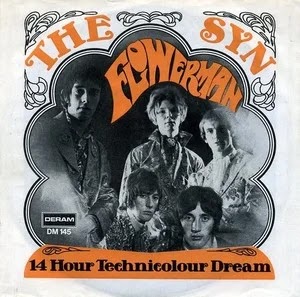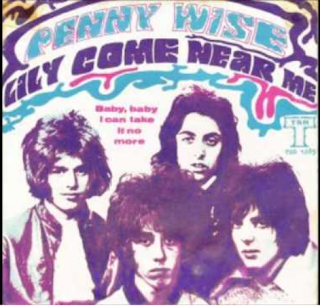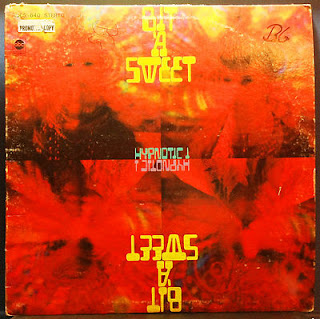MIND
DE-CODER 92
To listen to the show just tscroll to the bottom of the page
I will drop every tab in the land, just to assure you I am your man.
Julian Cope
THE
MOVE FIRE BRIGADE
I
seem to be enjoying a bit of a love-in with The Move at the moment – and long
may it continue. The mighty Fire Brigade, released in 1968, saw
the band at the very height of their imperial phase - it’s a killer single
combining a compelling pop sensibility with an off-kilter psychedelic sense of
playfulness, but what I like about it, what I really like about it, is
that ‘ooh’, interjected by Carl Wayne, that concludes the end of each
chorus. I find myself looking forward to
it each time the needle hits the groove.
THE
SYN 14 HOUR TECHNICOLOUR DREAM
This
paean to the legendary 14 Hour Technicolour Dream - held in the Great Hall of
the Alexandra Palace, London, on 29 April 1967 – is tucked away on the b-side
of the band’s second single, Flowerman, released later that year. I suspect
the band were in the audience that night– I can’t find a record of their
performing at the event and, oh, my goodness, how I wish I could have been
there. It’s what time machines will be invented for. Sometimes it makes me
physically ill that I missed growing up in the 60s. The band themselves have
something of a complicated history – they split later that year and half of its
members at some point turned in Yes. They never released an album at the time
but a version of the band seems to have reformed in 2004, and they appear to
have some seven albums or so under their belt. Of a progressive nature, I
understand.
SUMMER’S
CHILDREN MILK AND HONEY
Summer's
Children were the duo of Curt Boettcher and Victoria Winston, who recorded their
only single, the lovely Milk and Honey, in late 1965. Boettcher would go
on to help pioneer California sunshine pop with a number of groups, his
production skills creating jewels of pristine beauty. The sublime Milk And
Honey is pop perfection – a teenage symphony to God. By some accounts,
Boettcher set the bar for Brian Wilson to follow, although he remains largely
unknown these days following his death at the unlikely age of 42. This track,
and two more in the show, can be found on a new release, LOOKING FOR THE SUN,
which showcases his unique talent.
PENNY
WISE LILY COME NEAR ME
Supercool
Dutch freakbeat from Penny Wise, a band about which I know very little. Lily
Come Near Me was their second single, released in 1968, and comes over like
a cross between the Zombies and Koobas – a perfect psych-pop release.
BIT
‘A SWEET IF I NEEDED SOMEONE
The
regrettably monikered Bit ‘A Sweet were put together by producer Steve Duboff
to satisfy some kind of psychedelic itch he had that clearly need scratching.
The album, HYPNOTIC 1, released in 1968, is awash with psych-lite pop mixed with
distinctive flourishes of experimentation (notably quite a bit of electric
sitar, phasing, various studio effects and the early squelch of a synthesiser) but
comes over as less of a genuine artefact and more of a studio cash-in on the
psychedelic era. It sunk without a trace, but there’s no denying that their take
of George Harrison’s If I Needed Someone, complete with entirely
superfluous oscillator adornments, is a spacey, lysergic gem of a track that
deserves to be included in any list of superior Beatles’ cover versions.
NATHAN
HALL AND THE SINISTER LOCALS THE
WEDDING
The Wedding is a woozy, transcendent delight that, perhaps, hints at an
enjoyable new direction for Nathan Hall’s Sinister Locals. It has no official
release but appeared recently online and may be included on the band’s fourth
album. It’s hardly there but floats, instead, on gossamer wings; a
kaleidoscopic thing of spell-binding wonder; fragile yet absolutely in love
with its own sound. Absolutely gorgeous.
THE MARMALADE MAN IN A SHOP
The Marmalade
were a group doomed never to be taken seriously, despite, or perhaps because
of, their worldwide Number 1 hit with a cover of The Beatles’ Ob-La-Di,
Ob-La-Da that seemed to cement their fate as a novelty bubblegum act when,
in fact, they saw themselves more at home to American soul, folk-rock, and
progressive rock. Their fourth single, Man In A Shop, released in 1968,
is as an irresistible slice of psych-pop as you’re ever likely to hear, but,
sadly, the record-buying public did, in fact, resist its charms. Luckily, for
good or bad, Ob-La-Di, Ob-La-Da awaited.
THE
KINKS FANCY
The
Kinks, of course, didn’t do psychedelia, but Fancy, a hypnotic
Eastern-tinged rumination, is clearly playing with its nascent tropes even if Ray
Davies was later to discard them for a more reflective type of song-craft. It appears
on the band’s 1966 release, FACE TO FACE, a loose concept album on which Davies
explores English class and social structures, and pretty much marks the
beginning of their imperial phase.
I
don’t think the Peanut Butter Conspiracy were ever quite as good as their name
suggested, but you can almost smell the patchouli emanating from the sublimely
psychedelic Too Many Do, taken from their second album THE GREAT
CONSPIRACY, released in 1968. I believe that this track became one of the first
long cut recordings to be featured in extended radio play, as bands began to
escape the tyranny of the three-minute pop single.
GOLDENROD KARMIC DREAM SEQUENCE
With
a title like this you’d expect something a bit special, and Karmic Dream
Sequence doesn’t disappoint. Goldenrod were a studio project put together
by the now semi-legendary Curt Boettcher, consisting of the "Our
Productions" crew, a talented group of record producers and session men. Karmic
Dream Sequence, from their only album GOLDENROD, released in 1969, is
amazing – a sprawling, effects-laden, stoned acid-rock jam which features a
ten-minute cymbals solo that can only ever have made sense as a fried decade
drew to a close. Marvellous.
TREES SALLY FREE AND EASY
This
remarkable track, a cover of Cyril Tawney’s tale of heartbreak and woe, Sally
Free And Easy, is taken from the band’s second album, ON THE SHORE,
released in 1970. They were hardly known at the time, and even now they’re
regarded, in some circles, as Fairport-lite, very much a second-tier act in
your acid-folk circles, but I think this track is pretty close to astonishing.
Recorded in one take, it blends strong elements of prog, psychedelia and folk
with the charming voice of singer Celia Humphris (now, apparently the voice of
the Northern Line, fact fans) sends shivers down the spine. The album cover invites
as much comment as the contents within. Designed by Hipgnosis, the model in the
photo was Katie Meehan, daughter of Tony Meehan from The Shadows.
CIRCUS PLEASURES OF A LIFETIME
Well,
this is just lovely: “How nice it is to have enjoyed the pleasures of a
lifetime”, they sing, and sound as if they really mean it. Circus started
life as a psych-pop outfit whose two singles were largely ignored by radio
stations and the record-buying public alike, before turning into what can only
be called a jazz-fusion band who mixed the heavier aspects of late 60s prog
with the nuances of jazz modulations, folk, pop and psychedelia. The result was
surprisingly successful, and their only album, CIRCUS, released in 1969 is a
very mellow listen. Pleasures Of A Lifetime is a beautifully serene song
which, admittedly, features a mid-section Jazz break which isn’t entirely
necessary, but overall this is my favourite track on this evening’s show.
Sweetly gorgeous.
THE
ORACLE DON’T SAY NO
The
Oracle were one of those bands doomed to be a footnote to a footnote in your
psychedelic circles – in this case the footnote once again belongs to Curt
Boettcher. This is the b-side to the band’s only single, released in 1967, produced
and co-written by Boettcher in which otherworldly vocals lurch into life with a
swell of compressed cymbals and exotic instrumentation. I confess I’d never
heard of Boettcher until last week, but I’m clearly quite taken with him.
HARMONY
GRASS I’VE SEEN TO DREAM
Sunshine
pop of the highest order by Harmony Grass – previously known as Tony Rivers and
The Castaways, but, by the end of 1968, that sort of name was sounding old. As
Harmony Grass, they troubled the charts with their first single release, so
their record company allowed them to record an album, resulting in THIS IS US,
released in 1969. In many ways it’s the epitome of British Sunshine Pop, showcasing
the band's love of the Beach Boys while also displaying a penchant for the
likes of The Turtles, The Association and Harper’s Bizarre. I’ve Seen To
Dream, however, is all Brian Wilson and wouldn’t sound out of place on PET
SOUNDS. The band split in 1970 but Tony Rivers went onto a career that included
a stint promoting the theme tune to the wistful 1970s sitcom, ‘Whatever
Happened To The Likely Lads’ in the highly made-up band, Highly Likely.
WEEPING
BONG BAND EGRESS AND NADIR
You
can’t really go wrong with a name like this and the band don’t disappoint. A
multi-sourced collaboration which, amongst a host of other names and bands I’ve
never heard of, includes P.G. Six, whose abstract, experimental folk
compositions have graced Mind De-Coder before. In fact, that reference is your
gateway into the band’s second album, simply called II, from which this track
is taken. The music stretches and explores, poised and restrained, allowing
plenty of space for your thoughts to roam hither and tither while your brain
melts like butter left too long in the sun.
TAME
IMPALA BREATHE DEEPER
To
be honest, whilst quietly applauding Kevin Parker’s journey as a musician and
producer these past few years, I didn’t think I was ready to join him for his
current album, which, if the lead singles were anything to go by, was just a
bit 10cc does Supertramp at some yacht-rock festival in Belgium, and not enough
psychedelic abandon for me. And then I heard it under, what I'm coyly choosing to refer to as enhanced circumstances, and was suitably thrilled to
discover that THE SLOW RUSH is as trippy as a pair of Persian slippers on the
psychedelic stairway of destiny; an aural slowdive into a warm summer’s day. Breathe
Deeper is a funky, blissed-out disco affair featuring a languorous groove, jumping
drum beats, and bejewelled electric piano melodies tethered by lysergic
playfulness. Quite, quite gorgeous.
B-MOVIE
ORCHESTRA BASS IN LOVE
Eagle-eared
listeners will have noted that I lead into the exotica part of the show with
one of Jerry Goldsmith’s musical interludes for the film ‘Our Man Flint’ (All
I Have To Do Is Take A Bite Of Your Apple?, to be precise), which I blend
seamlessly (if I do say so myself) into the B-Movie Orchestra’s flawlessly
erotique cover of Guy Pedersen’s Bass In Love. B-Movie Orchestra are the
musical brainchild of Matti Baz (the drummer of Junkie XL, if that’s any use)
and Ellen ten Damme (Dutch actress and multi-instrumentalist) to allow them to
indulge their passion for the groovy, psychedelic soundtracks that accompanied
Italian police films, spaghetti westerns, soft erotica and 60s spy movies.
Their debut album, THE ULTIMATE IN THRILLING, EROTIC AND RAUNCHY FILM MUSIC
VOLUME 1, released in 2012, pretty much does what it says on the label.
KAVA
KON PACIFICA 66
The
L.A. based duo Kava Kon are clearly worshippers of the likes of Martin Denny
and Arthur Lyman, and their second album, TIKI FOR THE ATOMIC AGE, released in
2009, channels the spirit of both with an evocative mix of exotica,
electronica, soundtrack, dub, western, world beat, ambient, and lounge, suitably
loaded with vintage organ sounds, exotic percussion, and gloriously cheesy
approximations of Rumba and Bossa Nova. Many people still regard the exotica
records in the mid-50s as camp novelties, but what you’re getting are
mini-atmospheric masterpieces, notable for their use of non-musical sounds and
unorthodox production techniques, which is where the attraction for me comes
in. Pacifica 66 reverberates with three-note vibraphone structures and
three layers of female vocals with occasionally added laser followed by an
ambient intermission featuring relaxing ocean waves and a melody quietly
plucked on a distant acoustic guitar. I’ve been a fan of this sort of thing for
years – I can’t imagine why it’s taken so long to include an exotica element
into the show.
PAUL
WELLER IN ANOTHER ROOM
The
title track from Paul Weller’s uncanny little release on Ghostbox records on
which the modfather explores his interest in experimental tape music and early
electronics. The whole EP comes in at less than 8 minutes but in that time, you
get tape manipulation, field recordings and instrumental passages artfully
arranged to create a genuinely curious and psychedelic atmosphere.
DON
RANDI TRIO SLEEPY LAGOON
Is
this the theme music to Radio 4’s flagship Desert Island Discs? I believe it
is. Presented here by the Don Randy Trio (featuring Curtis Amy and The Exotic
Strings) from the 1966 release, JUNGLE ADVENTURES IN MUSIC AND SOUND, it
provides a suitably relaxing end to the show, allowing the mind to drift
untethered into far reaches of infinity (and perhaps, just perhaps, beyond).
The rest of the album is notable for using every sound in the exotica effects
library and is gloriously overwhelming.























No comments:
Post a Comment